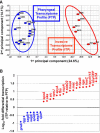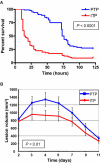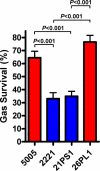Genome-wide analysis of group a streptococci reveals a mutation that modulates global phenotype and disease specificity
- PMID: 16446783
- PMCID: PMC1354197
- DOI: 10.1371/journal.ppat.0020005
Genome-wide analysis of group a streptococci reveals a mutation that modulates global phenotype and disease specificity
Abstract
Many human pathogens produce phenotypic variants as a means to circumvent the host immune system and enhance survival and, as a potential consequence, exhibit increased virulence. For example, it has been known for almost 90 y that clinical isolates of the human bacterial pathogen group A streptococci (GAS) have extensive phenotypic heterogeneity linked to variation in virulence. However, the complete underlying molecular mechanism(s) have not been defined. Expression microarray analysis of nine clinical isolates identified two fundamentally different transcriptomes, designated pharyngeal transcriptome profile (PTP) and invasive transcriptome profile (ITP). PTP and ITP GAS differed in approximately 10% of the transcriptome, including at least 23 proven or putative virulence factor genes. ITP organisms were recovered from skin lesions of mice infected subcutaneously with PTP GAS and were significantly more able to survive phagocytosis and killing by human polymorphonuclear leukocytes. Complete genome resequencing of a mouse-derived ITP GAS revealed that the organism differed from its precursor by only a 7-bp frameshift mutation in the gene (covS) encoding the sensor kinase component of a two-component signal transduction system implicated in virulence. Genetic complementation, and sequence analysis of covR/S in 42 GAS isolates confirmed the central role of covR/S in transcriptome, exoproteome, and virulence modulation. Genome-wide analysis provides a heretofore unattained understanding of phenotypic variation and disease specificity in microbial pathogens, resulting in new avenues for vaccine and therapeutics research.
Conflict of interest statement
Figures





Similar articles
-
CovS inactivates CovR and is required for growth under conditions of general stress in Streptococcus pyogenes.J Bacteriol. 2004 Jun;186(12):3928-37. doi: 10.1128/JB.186.12.3928-3937.2004. J Bacteriol. 2004. PMID: 15175307 Free PMC article.
-
Analysis of the role of CovR and CovS in the dissemination of Streptococcus pyogenes in invasive skin disease.Microb Pathog. 2006 May;40(5):221-7. doi: 10.1016/j.micpath.2006.01.005. Epub 2006 Mar 20. Microb Pathog. 2006. PMID: 16542816
-
The Streptococcus pyogenes orphan protein tyrosine phosphatase, SP-PTP, possesses dual specificity and essential virulence regulatory functions.Mol Microbiol. 2015 Aug;97(3):515-40. doi: 10.1111/mmi.13047. Epub 2015 May 29. Mol Microbiol. 2015. PMID: 25939957
-
Virulence control in group A Streptococcus by a two-component gene regulatory system: global expression profiling and in vivo infection modeling.Proc Natl Acad Sci U S A. 2002 Oct 15;99(21):13855-60. doi: 10.1073/pnas.202353699. Epub 2002 Oct 7. Proc Natl Acad Sci U S A. 2002. PMID: 12370433 Free PMC article.
-
The two faces of Janus: virulence gene regulation by CovR/S in group A streptococci.Mol Microbiol. 2007 Apr;64(1):34-41. doi: 10.1111/j.1365-2958.2007.05649.x. Mol Microbiol. 2007. PMID: 17376070 Review.
Cited by
-
Group B Streptococcus CovR regulation modulates host immune signalling pathways to promote vaginal colonization.Cell Microbiol. 2013 Jul;15(7):1154-67. doi: 10.1111/cmi.12105. Epub 2013 Jan 30. Cell Microbiol. 2013. PMID: 23298320 Free PMC article.
-
Acquisition of the Sda1-encoding bacteriophage does not enhance virulence of the serotype M1 Streptococcus pyogenes strain SF370.Infect Immun. 2013 Jun;81(6):2062-9. doi: 10.1128/IAI.00192-13. Epub 2013 Mar 25. Infect Immun. 2013. PMID: 23529618 Free PMC article.
-
Serotype M3 and M28 Group A Streptococci Have Distinct Capacities to Evade Neutrophil and TNF-α Responses and to Invade Soft Tissues.PLoS One. 2015 Jun 5;10(6):e0129417. doi: 10.1371/journal.pone.0129417. eCollection 2015. PLoS One. 2015. PMID: 26047469 Free PMC article.
-
The small regulatory RNA FasX enhances group A Streptococcus virulence and inhibits pilus expression via serotype-specific targets.Mol Microbiol. 2015 Apr;96(2):249-62. doi: 10.1111/mmi.12935. Epub 2015 Feb 4. Mol Microbiol. 2015. PMID: 25586884 Free PMC article.
-
Null Mutations of Group A Streptococcus Orphan Kinase RocA: Selection in Mouse Infection and Comparison with CovS Mutations in Alteration of In Vitro and In Vivo Protease SpeB Expression and Virulence.Infect Immun. 2016 Dec 29;85(1):e00790-16. doi: 10.1128/IAI.00790-16. Print 2017 Jan. Infect Immun. 2016. PMID: 27795364 Free PMC article.
References
-
- Kotb M, Norrby-Teglund A, McGeer A, El-Sherbini H, Dorak MT, et al. An immunogenetic and molecular basis for differences in outcomes of invasive group A streptococcal infections. Nat Med. 2002;8:1398–1404. - PubMed
LinkOut - more resources
Full Text Sources
Other Literature Sources
Molecular Biology Databases

